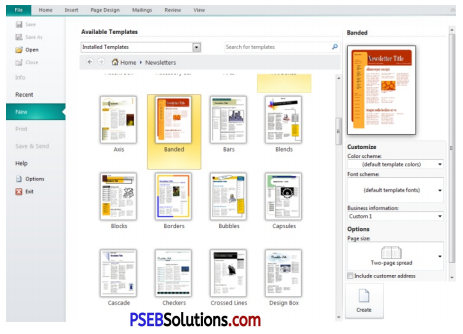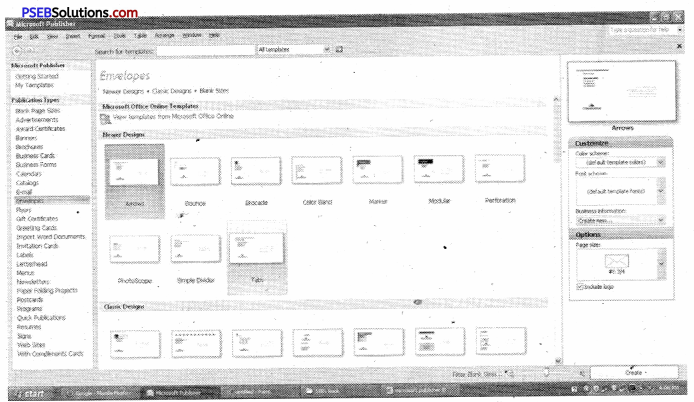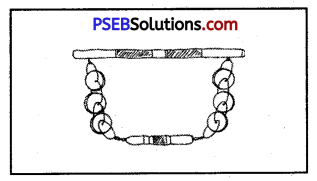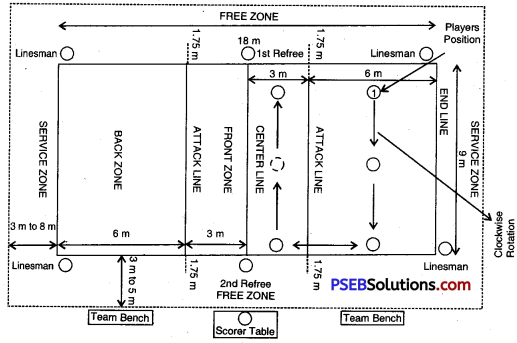Punjab State Board PSEB 12th Class Political Science Book Solutions Chapter 16 India and SAARC Textbook Exercise Questions and Answers.
PSEB Solutions for Class 12 Political Science Chapter 16 India and SAARC
Long Answer Type Questions
Question 1.
Write a note on establishment (formation) of SAARC and discuss its objectives.
Or
Describe background and efforts made for the establishment of South Asian Association for Regional Co-operation (SAARC).
Answer:
The quest for regional co-operation in South Asia, as initiated by the late Zia-Ur-Rahman of Bangladesh in March, 1980, was given concrete foundation with the emergence of SAARC (South Asian Association for Regional Co-operation) in August, 1983. On August 1, 1983, foreign ministers of seven countries (Bangladesh, Bhutan, India, Maldives, Nepal, Pakistan and Sri Lanka) met at New Delhi and approved programme of economic co-operation. They decided on an integrated programme of action for regional co-operation. Thus, the seven South Asian countries formally established the SAARC in 1985.
In its 14th Summit which was held at New Delhi on April 3-4-2007, Afghanistan becomes the 8th member of SAARC.
Background And Efforts Made for the Establishment of SAARC:
1. Working Paper on SAARC:
Before the formal launching of SAARC, useful and productive ground work was done by several meetings of the seven South Asian states. The working paper was prepared by Bangladesh’s former President Mr. Zia-Ur-Rehman. He stressed the need of setting up an organisation to promote regional co-operation.
2. Colombo Meeting of the Foreign Ministers of South Asian States (1981):
At this meeting the foreign ministers of South Asian countries- India, Nepal, Bhutan, Bangladesh, Pakistan, Sri-Lanka and Maldives, acknowledged the importance of regional co-operation. The meeting agreed to explore the possibilities of co-operation in five spheres i.e. agriculture, rural development, communication, weather and health and population activities.
3. Foreign Secretaries. Meeting in Kathmandu (1981):
At this meeting the recommendations of the seven nation study group and the report of the coordination committee of the whole was accepted. It also decided to explore the possibilities of Transport, Postal Service and Scientific and Technological cooperation.
4. Islamabad Meeting of Foreign Secretaries (1982):
This meeting approved the recommendations of the study group set up in Kathmandu and decided to constitute new study groups on sports, arts and culture.
5. Dhaka Meeting (1983):
This meeting evaluated the mutual co-operation in different fields and recommended the adoption of integrated programme of action by the foreign ministers. It also decided to set up a standing committee.
6. New Delhi Meeting of Foreign Ministers (1983):
In this meeting the foreign ministers signed the declaration of South Asian regional cooperation. The declaration listed the following objectives of South Asian Regional Co-operation.
- to promote the welfare of the people of South Asia and to raise their standard of living,
- to accelerate economic growth, social progress and cultural development in the region;
- to promote and strengthen collective self-reliance among these countries,
- to contribute to mutual trust, understanding and appreciation of one another’s problems;
- to promote active collaboration and mutual assistance in various fields;
- to strengthen co-operation among themselves and regional forums; and
- to co-operate with international and regional organisations with similar aims and objectives.
The declaration also stated that SAARC is based on respect for the principle of sovereign equality; territorial integrity, political independence, non¬interference in the international affairs of other states and mutual benefits. The heads of state or government meet annually. It also decided to set up different committees.
7. New Delhi Meeting (1984):
This meeting gave a call for developing friendly relations among the countries of this region, along with co-operation in socio-economic and cultural field.
8. Standing Committee Meeting in Male in Feb. 1985:
This meeting recommended the establishment of a ministry council of South Asian countries through which the common will of mutual co-operation could be given institutional form. Thus, after so much hard work, studies and meeting SAARC was formally inaugurated in Dec. 1985.
Objectives and Principles of SAARC:
The South Asian Association of Regional Co-operation was formally inaugurated in Dec. 1985. The SAARC is an organisation of Eight countries of South Asia:Bhutan, India, Afghanistan, Bangladesh, Maldives, Nepal, Pakistan and Sri Lanka. SAARC was established primarily for co-operation in agriculture, rural development, science and technology, culture, health, population control, narcotics and terrorism.
Objectives of SAARC:
The objectives of the association are : 1. to promote the welfare of the people of South : 2. to accelerate economic growth, social progress and cultural development in the region; 3. to promote and strengthen collective self-reliance among these countries. 4. to contribute to mutual trust, understanding and appreciation of one another’s problems; 5. to promote active collaboration and mutual assistance in various fields; 6. to strengthen co-operation among themselves and regional forums; and 7. to co-operate with international and regional organisations.
Principles of SAARC:
- SAARC is based on the principles of sovereign equality; territorial integrity, political independence, non-interference in the internal affairs of other states and mutual benefits.
- Decisions at all levels are taken on the basis of unanimity. But bilateral and contentious issues will be excluded from the deliberations.
- SAARC is not a political organisation but is formed to accelerate development through mutual co-operation.
- The members of SAARC would not act as obstruction in having relations with the individual countries of SAARC and with other countries.

Question 2.
What important activities SAARC has taken up during its existence? What has been India’s role in them?
Answer:
SAARC is active since 1985. It has taken up many activities as a regional co-operation association. It’s activities are as follows :
First SAARC Summit:
The leaders of seven South Asian countries Bangladesh, Bhutan, Sri Lanka, Maldives, Nepal, Pakistan and India, concluded on Dec. 8, 1985. at Dhaka their first ever regional summit. The Summit Conference adopted a Charter of this regional body to be known as South Asian Association for Regional Co-operation. This marked a major development in co-operation among the countries of the region. It will also help in the maintenance of peace and stability in the area.
Second Summit of SAARC:
The second summit of SAARC was held at Bangalore on Nov. 16-17, 1986 under the Chairmanship of Sh. Rajiv Gandhi. It decided to evolve a joint policy to fight terrorism in South Asia, to set up technical committees on women’s participation in development, drug abuse and drug trafficking.
Third Summit of SAARC:
The third summit of SAARC was held at Kathmandu (Nepal) in Nov. 1987, where agreements were reached on terrorism and established a SAARC Reserved Food Grain Stock. The Reserved Food Grain Stock, launched at the summit, will begin with a stock of 200,000 tonnes of wheat and rice. The summit also decided to commission a comprehensive study of the region’s environment and the necessary measures for its protection and preservation.
Fourth SAARC Summit:
The fourth annual summit of SAARC ended in Islamabad on December 31, 1988. The summit pledged to stamp out terrorism and meet the basic needs of the people through a regional plan ‘SAARC 2000’ with specific targets.
Fifth SAARC Summit 1990:
Fifth SAARC summit was held in Male, the capital of Maldives, in November, 1990. The summit decided to enlarge visa-free travel facilities beyond the present categories of members of Parliament and Supreme Court Judges.
Ninth Session of SAARC Council of Ministers, 1991. On July 4, 1991 the Ninth Session of the SAARC Council of Ministers agreed on taking co-ordinated action to combat the menace of terrorism which they said threatened to destabilize the region. On the economic front, the SAARC Council-also approved to institutionalise co-operation in tourism and trade manufacture and service.
Sixth SAARC Summit 1991:
Sixth SAARC summit was held in Colombo, the capital of Sri Lanka, on Dec. 21, 1991. The seven SAARC nations have agreed to liberalise trade and called for greater co-operation and interaction among the member states to combat terrorism in the region. India has done well by proposing a collective economic security system for the region.
Seventh SAARC Summit 1993:
Seventh SAARC summit was held at Dhaka, the capital of Bangladesh, on April, 1993. The South Asian Association for Regional Co-operation entered a new phase of economic co-operation as the seventh summit approved the 63 point Dhaka declaration and endorsing the South Asia Preferential trade agreement seeking to reduce trade barriers in the region.
Eighth SAARC Summit 1995:
Eighth SAARC summit was held in New Delhi on 2nd May, 1995. All the members of SAARC countries agreed to liberalise trade and called for greater co-operation. Delhi declaration of the eighth SAARC summit called for an international convention prohibiting the use or threat of use of nuclear weapons under any circumstances and strongly deploring acts of terrorism spreading in and outside the region. The declaration called for the production of organised tourism in a big way in the SAARC region. Another significance of this Summit was agreement on South Asian Preferential Trading Arrangement (SAPTA).
Ninth SAARC Summit 1997:
Ninth SAARC summit was held at Male, the capital of Maldives on 11th May, 1997. Leaders of seven South Asian nations accepted India’s proposal to transform the region into a free trade area by 2001. SAARC countries agreed for the removal of all trade barriers and structural impediments by advancing the deadline by four years from the earlier agreed goal of SAFTA by 2005.
Tenth SAARC Summit 1998:
Tenth SAARC summit was held at Colombo on 29th July, 1998. Despite its failings and shortcomings, SAARC has taken several bold steps including establishing a framework for SAPTA (South Asian Preferential Trade Arrangement) and SAFTA (South Asian Free Trade Area). India made a fine gesture that it would remove import restrictions on over two thousand products to facilitate intra-regional trade. With the solitary exception of Pakistan, all other member-countries of SAARC also agreed on the need to hasten the process by two years to realise SAFTA by 2001.
Eleventh SAARC Summit, 2002:
The Eleventh SAARC summit was held at Kathmandu, the capital of Nepal on 5th Jan. 2002 under tenscious shadow of Indo- Pak relations. The 11th SAARC Summit decided for the urgent conclusion of comprehensive convention on combating International terrorism and conducting international cooperation in ending this scourge in conformity with the U.N. Charter. The Summit recognised the importance of creating a free trade area. The declaration called for coordination among the SAARC member states on all World Trade Organisation issues.
Twelfth SAARC Summit (2004):
The 12th SAARC Summit was held at Islamabad; the capital of Pakistan in January 2004. During this summit firstly, SAFTA was approved and it will take effect from January, 2006. Secondly, all the SAARC nations signed its ‘Social Charter’. Thirdly, it was decided to start a ‘SAARC Award’ to respect and encourage the contribution of individual in the spheres of peace, poverty alleviation, social welfare etc. Fourthly, the SAARC nations signed a protocol on the prevention of terrorism.
Thirteenth SAARC Summit (2005):
The 13th SAARC summit was held at Dhaka on November 12, 2005. Summit decided a united fight against terrorism afflicting the region.
Fourteenth SAARC Summit:
The Fourteenth SAARC Summit was held at New Delhi on April 3-4, 2007. All the eight members were present. Afghanistan is the latest addition in the SAARC and because of this addition the total members of the SAARC are eight now. SAARC Summit adopted a 30-point declaration with commitment to ensure market access by all SAARC member countries and also collectively combat poverty, diseases, disaster and terrorism. All the eight members of the SAARC were unanimous for taking strict steps to curb terrorism in the Universe. Two agreements on establishing South Asian University and SAARC Food Bank were signed in the concluding session of the 14th SAARC Summit in New Delhi.
Fifteenth SAARC SUMMIT:
The Fifteenth SAARC Summit was held in Colombo, SRI LANKA on August, 2-3, 2008. The Summit concluded with the leaders expressing serious concern over the threat posed by terrorism to the peace, stability and security of the region and emphasizing the need for strongest possible co-operation in fighting terror and transnational organised crime. The Summit adopted the Colombo Declaration titled ‘Partnership for the growth of our people’ at the concluding session on August 3. The declaration stressed the importance of completing all legislative and other relevant measures to implement within the member states the provisions of the Regional Convention on Narcotic Drugs and Psychotropic substances.
Sixteenth SAARC Summit:
The Sixteenth SAARC Summit was held in Thimpu, Bhutan on April 28-29, 2010. The Summit concluded with the leaders express serious concerns over terrorism. SAARC leaders also decided to celebrated the decade of 2011-2020 as a ‘Decade of Intraregional Connectivity in SAARC’.
17th SAARC Summit (2011):
The 17th SAARC Summit was held in Addu (Maidive) on Nov. 10-11, 2011. The Addu declaration said that the leaders agreed upon the theme of ‘Building Bridges.’ The leaders committed to work towards a huge boost in intra SAARC trade, improving air, rail, motor and water transport connectivity between member countries and putting their heads together to solve common development concerns.
18th SAARC Summit-2014:
The 18th SAARC Summit was held in 2014 in Nepal. It concluded adopting a 36-point declaration with commitment to control Terrorism and Religious Fundamentalism.
India’s Role in SAARC :
India has been playing a vital role in the activities of SAARC. To make this organisation a success India has made constructive contributions. Its contributions in the founding and functioning of the organisation are significant and these are as follow:
- India played a leading role in the formation of SAARC. With India’s effort SAARC was constituted in 1985 with a view to promote co-operation in the neighbouring countries.
- The second SAARC Summit was held in Bangalore in 1986 under the chairmanship of Late Prime Minister Sh. Rajiv Gandhi.
- India announced a grant of Rs. 150 lacs to SAARC for the year 1987-88.
- In 1988, India offered 1,53,200 tonnes of foodgrains to create a reserved foodgrains stock for SAARC nations.
- India announced a contribution of Rs. 2 crores for SAARC activities for the year 1989-90.
- Industrial Development Bank of India hosted a meeting of national development institutions of the member countries in October 1991.
- In Dec. 1991, during the Sixth SAARC Summit India proposed a collective economic security system for the region.
- India hosted the first cultural festival of SAARC countries in October, 1992.
- India also ratified SAARC convention on Narcotic Drugs.
- The Eighth SAARC Summit was held in New Delhi on 4 May, 1995.
- The first SAARC Trade fair was also held in New Delhi from 9th to 14th January, 1996.
- India has removed all Quantitative Restrictions from SAARC countries from August 1, 1998.
- To boost the trade within the region India has placed over 2000 products from the Restricted List to Open General List.
- Under SAPTA India offered duty concessions to SAARC nations on 160 items.
- India has offered to conclude bilateral free trade agreements with those SAARC nations who are willing to move faster.
- India has already free trade agreements with Nepal and Bhutan.
- India has given financial aid to SAARC nations on a large scale particularly to Nepal, Bhutan and Maldives.
- In 12th SAARC Summit India pledged a contribution of Rs. 21.5 million for conferences to give concrete shape to freeing the SAARC region from hunger and giving an added impetus to the SAARC food bank.
- In the 13th SAARC Summit India offered concrete proposals to strengthen, including the facility of daily air services by designated airlines on a reciprocal basis, provision of transit facilities, setting up of a South Asian University and establishment of Regional Food Bank, SAARC High Economic Council and SAARC Museum of Textiles and Handicrafts.
Thus, India has played a constructive role in SAARC. It has always helped the member-states in time of need and emergency. India’s role in SAARC activities is a mark of India’s firm belief in SAARC and its policies.

Question 3.
Describe India’s role in SAARC.
Answer:
India has been playing a vital role in the activities of SAARC. To make this organisation a success India has made constructive contributions. Its contributions in the founding and functioning of the organisation are significant and these are as follow:
- India played a leading role in the formation of SAARC. With India’s effort SAARC was constituted in 1985 with a view to promote co-operation in the neighbouring countries.
- The second SAARC Summit was held in Bangalore in 1986 under the chairmanship of Late Prime Minister Sh. Rajiv Gandhi.
- India announced a grant of Rs. 150 lacs to SAARC for the year 1987-88.
- In 1988, India offered 1,53,200 tonnes of foodgrains to create a reserved foodgrains stock for SAARC nations.
- India announced a contribution of Rs. 2 crores for SAARC activities for the year 1989-90.
- Industrial Development Bank of India hosted a meeting of national development institutions of the member countries in October 1991.
- In Dec. 1991, during the Sixth SAARC Summit India proposed a collective economic security system for the region.
- India hosted the first cultural festival of SAARC countries in October, 1992.
- India also ratified SAARC convention on Narcotic Drugs.
- The Eighth SAARC Summit was held in New Delhi on 4 May, 1995.
- The first SAARC Trade fair was also held in New Delhi from 9th to 14th January, 1996.
- India has removed all Quantitative Restrictions from SAARC countries from August 1, 1998.
- To boost the trade within the region India has placed over 2000 products from the Restricted List to Open General List.
- Under SAPTA India offered duty concessions to SAARC nations on 160 items.
- India has offered to conclude bilateral free trade agreements with those SAARC nations who are willing to move faster.
- India has already free trade agreements with Nepal and Bhutan.
- India has given financial aid to SAARC nations on a large scale particularly to Nepal, Bhutan and Maldives.
- In 12th SAARC Summit India pledged a contribution of Rs. 21.5 million for conferences to give concrete shape to freeing the SAARC region from hunger and giving an added impetus to the SAARC food bank.
- In the 13th SAARC Summit India offered concrete proposals to strengthen, including the facility of daily air services by designated airlines on a reciprocal basis, provision of transit facilities, setting up of a South Asian University and establishment of Regional Food Bank, SAARC High Economic Council and SAARC Museum of Textiles and Handicrafts.
Thus, India has played a constructive role in SAARC. It has always helped the member-states in time of need and emergency. India’s role in SAARC activities is a mark of India’s firm belief in SAARC and its policies.

Short Answer Type Questions
Question 1.
What do you know about SAARC? Write the names of its member countries.
Answer:
The quest for regional co-operation in South Asia, as initiated by late Zia- Ur-Rahman of Bangladesh in March 1980, was given a concrete foundation with the emergence of SAARC. The leaders of seven South Asian countries India, Bangladesh, Pakistan, Sri Lanka, Nepal, Bhutan and Maldives concluded on December 5, 1985 at Dhaka their first ever regional summit. The summit conference adopted a Charter of this regional body to be known as South Asian Association for Regional Co-operation.
This marked a major development in co-operation among the countries of this region. The Indian Prime Minister in his inaugural address termed it as the beginning of a new dawn. The Dhaka Declaration stated that the Heads of State or Government shall meet annually. The SAARC Secretariat was set up at Kathmandu on 16 January, 1987. In its 14th summit which was held at New Delhi on April, 3-4-2007, Afghanistan became the 8th member of SAARC. The basic aim of the organisation as declared by Dhaka Declaration is “to make the full use of all the human and natural resources and to accelerate the economic and social development of the region.”
Question 2.
Write main objectives of SAARC.
Answer:
The objectives of the association are:
- to promote the welfare of the people of South
- to accelerate economic growth, social progress and cultural development in the region;
- to promote and strengthen collective self-reliance among these countries.
- to contribute to mutual trust, understanding and appreciation of one another’s problems;
- to promote active collaboration and mutual assistance in various fields;
- to strengthen co-operation among themselves and regional forums; and
- to co-operate with international and regional organisations.

Question 3.
WHhat are the main principles of SAARC? Write the names of its member countries.
Or
Write down the names of the member countries of SAARC.
Answer:
Principles of SAARC:
- SAARC is based on the principles of sovereign equality; territorial integrity, political independence, non-interference in the internal affairs of other states and mutual benefits.
- Decisions at all levels are taken on the basis of unanimity. But bilateral and contentious issues will be excluded from the deliberations.
- SAARC is not a political organisation but is formed to accelerate development through mutual co-operation.
- The members of SAARC would not act as obstruction in having relations with the individual countries of SAARC and with other countries.
Names of the member countries of SAARC:
- India
- Pakistan
- Bangladesh
- Bhutan
- Maldives
- Sri Lanka
- Nepal,
- Afghanistan.
Question 4.
Write a short note on SAFTA.
Answer:
The aim of SAFTA is to establish a ‘South Asian Free Trade Area’ through mutual co-operation. A free trade area means that trading among the countries of the area is free from taxes and custom restrictions. During its establishment it was hoped that SAFTA will replace SAPTA before the start of 21st century. The Tenth SAARC Summit decided to set up a committee of experts to conclude on Treaty 2001 on SAFTA. In 12th SAARC Summit held on January, 2004 in Islamabad the SAARC nations have signed the treaty.
On December 29, 2005 the Union Cabinet of India cleared the implementation of South Asian Free Trade Area (SAFTA) agreement though the actual movement of commodities among Seven Nations started from July 1, 2006. SAFTA allows for a differential and progressively freer regions. India, in effect, will offer relatively unhindered access to its markets for Bangladesh, Bhutan, Maldives and Nepal, the poorest SAARC members, while different ‘sensitive lists’ on goods and services would be prepared for Pakistan and Sri Lanka.

Question 5.
Write down any four achievements of ‘SAARC’.
Answer:
- All the member countries of SAARC have come closer to one another and their mutual tension has been lessened.
- All the member countries are collectively working for their socio-economic development.
- SAARC has created “Food Stock Pool”. It has developed a sense of self-reliance and self-respect among SAARC nations.
- SAARC has accelerated development in the region.
Very Short Answer Type Questions
Question 1.
What do you know about SAARC?
Answer:
The quest for regional co-operation in South Asia, as initiated by late Zia- Ur-Rahman of Bangladesh in March 1980, was given a concrete foundation with the emergence of SAARC. The leaders of seven South Asian countries India, Bangladesh, Pakistan, Sri Lanka, Nepal, Bhutan and Maldives concluded on December 5, 1985 at Dhaka their first ever regional summit.
Question 2.
Write the full name of ‘SAARC’.
Answer:
The full name of SAARC is South Asian Association for Regional Cooperation.
Question 3.
Write down the names of SAARC member countries.
Or
Write the names of any four countries of SAARC.
Answer:
- India
- Pakistan
- Bangladesh
- Bhutan
- Maldives
- Sri Lanka
- Nepal,
- Afghanistan.
Question 4.
Write a short note on SAFTA
Answer:
The aim of SAFTA is to establish a ‘South Asia Free Trade Area’ through mutual co-operation. A free trade area means that trading among the countries of the area is free from taxes and custom restrictions.

Question 5.
Write down any two achievements of ‘SAARC’.
Answer:
- All the member countries of SAARC have come closer to one another and their mutual tension has been lessened.
- All the member countries are collectively working for their socio-economic development.
Question 6.
Write any two problems of SAARC.
Answer:
- The first problem is Political lnstability in the SAARC Region.
- The second problem of SAARC is Terrorism.
One Line Answer Type Questions
Question 1.
What is meant by SAARC?
Or
What is the full form of SAARC?
Answer:
SAARC i.e. South Assian Association for Regional Cooperation is an organisation of eight countries of South Asia. It has been established with the objective of increasing mutual co-operation between these countries.
Question 2.
When was SAARC established?
Answer:
A Conference of the Foreign Ministers of seven countries was held on 1-2 August, 1983. They deliberated about the establishment of SAARC. It was formally founded in its first conference at Dhaka in Bangladesh in 1985.
Question 3.
What has been the impact of SAARC as a means of Regional Co-operation?
Answer:
Because of SAARC, the South Asian Countries have come closer to each other. It has been successful in settling some common problems in these countries.

Question 4.
Mention full form of SAARC and SAFTA
Answer:
- SAARC: South Asian Association for Regional Co-operation.
- SAFTA: South Asian Free Trade Area.
Question 5.
When and where was the 18th SAARC Conference held?
Answer:
The 18th SAARC Summit conference was held at Thimpu, the capital of Nepal on Nov. 2014.
Question 6.
Write down names of member countries of SAARC.
Answer:
SAARC includes countries such as India, Pakistan, Sri Lanka, Nepal, Bhutan, Bengladesh, Maldives and Afganistan.
Question 7.
When and in which conference, Afganistan was made a member country of SAARC?
Answer:
Afganistan was made a member of SAARC in the 14th Summit Conference held in India in April, 2007.
Question 8.
Where is the office of SAARC situated?
Answer:
The office of SAARC is in Kathmandu, the capital of Nepal.
Question 9.
Write down any two countries in the north of India who have joined SAARC.
Answer:
In the north of India, Nepal and Bhutan are the member countries of SAARC.
Question 10.
Write down any two countries in the south of India who have joined SAARC.
Answer:
In the south of India, Sri Lanka and Maldives are the member countries of SAARC.

Question 11.
When was SAARC established?
Answer:
1985.
Question 12.
Write down any one name of the member country of SAARC.
Answer:
India.
Question 13.
How many conferences of SAARC have been held so far?
Answer:
There have been 18 Summit Conferences of SAARC so far.
Question 14.
Where was the 14th Summit Conference of SAARC held?
Answer:
In India.

Fill in The Blanks
1. The SAARC is an organisation of ………….. member states.
Answer:
Eight
2. ………….. is playing an important role in SAARC activities.
Answer:
India
3. First SAARC Summit was concluded on 8 Dec ………….. .
Answer:
1985
4. 17th SAARC Summit was held in ………….. .
Answer:
Maldives.

True Or False Statement
1. SAARC is a national organisation.
Answer:
False
2. SAARC is an Institution of South Asian countries.
Answer:
True
3. India is not a member of SAARC.
Answer:
False
4. Afghanistan becomes 8th member of SAARC.
Answer:
5. So far fifteen summits have concluded of SAARC.
Answer:
False.

Choose The Correct Answer
Question 1.
SAARC was initiated by:
(a) Mr. Zia-ul-Rehman
(b) Mr. Zia-ul-Haq
(c) Mrs. Indira Gandhi
(d) Mr. Mujib-ur-Rehman
Answer:
(a) Mr. Zia-ul-Rehman
Question 2.
SAARC is a/an:
(a) Universal Organisation
(b) Regional Organisation
(c) World Organisation
(d) International Organisation
Answer:
(b) Regional Organisation
Question 3.
The 18th Summit of SAARC
(a) India
(b) Sri Lanka
(c) Nepal
(d) Bhutan.
Answer:
(c) Nepal

Question 4.
The SAARC was formed
(a) 1987
(b) 1983
(c) 1985
(d) 1982.
Answer:
(b) 1983
![]()
![]()
![]()
![]()
![]()
![]()
![]()
![]()
![]()
![]()
![]()
![]()
![]()
![]()
![]()








